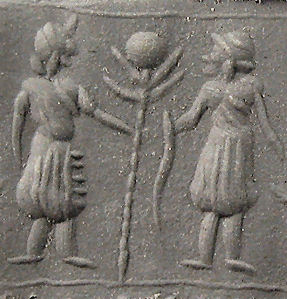A widely dispersed African myth tells that long ago Heaven and Earth were connected by a rope or ladder (or some other link) forming a primordial state of paradisical oneness between divinity and humankind. In the Nuer version of this myth human beings dwelt in the sacred presence of Kwoth. As long as they were able to climb the rope to heaven they could be rejuvenated at the point of death and descend to live their lives over again. This golden age eventually came to an end when Hyena (chaos beast) cut the rope. And so, due to this cosmic rupture, sickness, old age and death came to be. And as far as I can gather, the mythology fails to provide a way of divine return.
According to James Frazer, this state of death forevermore is also expressed in another prominent myth of the serpent that steals the lunar power of rebirth:
Many… …believe that, in virtue of the power of periodically casting their skins, certain animals and in particular serpents renew their youth and never die. Holding this belief, they tell stories to explain how it came about that these creatures obtained, and men missed, the boon of immortality.
Folk-Lore in the Old Testament:
Studies in Comparative Religion, Legend & Law: Chapter 2 – The Fall of Man: The Story of the Cast Skin (James Frazer)
Again, we find a similar myth in the Akkadian Gilgamesh Epic. After the Death of his beloved friend Enkidu, Gilgamesh heads out on a pilgrimage to overcome the horrors of death, only to discover, upon reaching the island of immortality (populated by the immortal Flood Hero Utu-napishtim and his nameless wife), immortality was a gift usually and exclusively reserved for the gods. However, Gilgamesh learns from Utu-napishtim and his wife, who prompted her husband to tell of a plant of rejuvenation that grows at the bottom of the ocean. Gilgamesh retrieves the plant, though not without wounding his hand (Wound Motif) as he picks it. After obtaining the plant…
Gilgamesh went down and was bathing in the water.
A snake smelled the fragrance of the plant [of rejuvenation],
silently came up and carried off the plant.
While going back it sloughed off its casing.’
At that point Gilgamesh sat down, weeping,
his tears streaming over the side of his nose.The Epic of Gilgamesh: Tablet 11
Gilgamesh’s failure to obtain the serpentine boon of rebirth, accepting that all things must die without much hope of a paradisical afterlife, bears some relation to the myth of the Serpent (collected by Frazer) who, as the gods covet the boon of solar-immortality, hordes the power of lunar-rebirth. I wonder if this was the case in earlier mythologies of the serpent’s power? Certainly this wasn’t the impression given in the Mysteries:
A fragment of Pindar, quoted by Clement of Alexandria (Miscellanies [Stromateis] 3.3.17), further focuses upon the happiness of one who has attained enlightenment through the Eleusinian mysteries: “Blessed is one who goes under the earth after seeing these things. That person knows the end of life, and knows its Zeus-given beginning.”
Meyer, Marvin W., 1999, ‘The Ancient Mysteries: A Sourcebook of Sacred Texts’, p.5 (University of Pennsylvania Press)
Joseph Campbell (Occidental Mytholgy: p, 10-11) sees the Mesopotamian serpent deity not as thief of the boon of rebirth, but instead, “the serpent…is generally favourable to those who, with due respect, approach the boon of his sanctuary.”. He also cites an Akkadian seal, apparently dated around 2350-2150 B.C., that according this his interpretation, depicts the serpent deity in human form holding aloft the lunar cup of rebirth to an initiate/devote, who is surely expected to drink to obtain the mysterious boon of lunar-rejuvenation (in whatever form that may of took).
I think there are many iconographic examples of the serpent as a cosmic manifestation of both the lunar-cosmic circle, and of course, there’s no shortage of symbols and myths of serpents associated with trees (of knowledge, life, healing, prosperity, et cetera.) that bestows a multitude of divine gifts upon mankind.

This image is taken from a Syrian cylinder seal (1000 BC), depicting two figures (the figure on the right holding what appears to be a serpent, identifying it with the Tree) flanking a type of Sun and Moon Tree (or standard). It’s in the form of a pole surmounted with a pair of lunar crescents containing an orb, that represents the sun (in other mythologies, especially in Hindu Texts, is a gateway to the gods).
July 29, 2009 at 3:31 pm |
Gilgamesh is written in a musical code, 2/3 being the musical dominant. It is applied to the zodiac, giving the story of G as prototype man with his spirit guide Enkidu. The tree can be seen as metaphor for the sun god, cut down and his body distributed, just as the flesh of the bull is eaten, his genitals thrown to the underworld, his head a teacher through the age of taurus. Enkidu at the head of the bull is in aries, the male shhep who now rules the earth etc etc